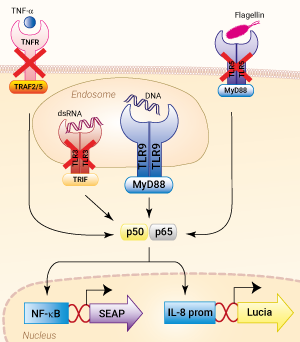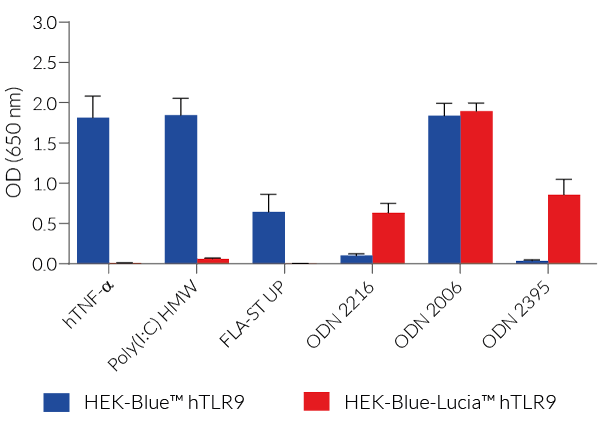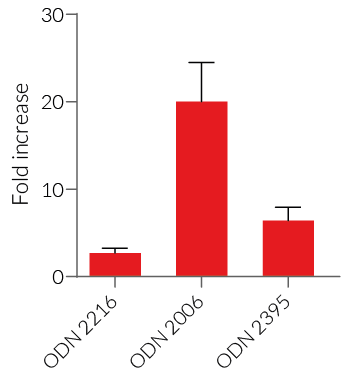Human TLR9 Reporter HEK293 Cells (NF-κB and IL-8)
| Product | Unit size | Cat. code | Docs. | Qty. | Price | |
|---|---|---|---|---|---|---|
|
HEK-Blue-Lucia™ hTLR9 Cells Human TLR9 expressing HEK293 dual reporter cells (NF-κB pathway) |
Show product |
3-7 x 10e6 cells |
hkd-htlr9ni
|
|
||
|
HEK-Blue-Lucia™ hTLR9 vial Additional cell vial |
Show product |
3-7 x 10e6 cells |
hkd-htlr9ni-av
|
Notification: Reference #hkd-htlr9ni-av can only be ordered together with reference #hkd-htlr9ni.
NF-κB–SEAP and IL-8–Lucia reporter HEK293 cells expressing human TLR9

Signaling pathways in HEK-Blue-Lucia™ hTLR9 cells
HEK-Blue-Lucia™ hTLR9 cells were engineered from the human embryonic kidney HEK293 cell line to study the Toll-like receptor 9 (TLR9). This important pattern recognition receptor (PRR) recognizes unmethylated CpG dinucleotides, a hallmark of microbial (bacterial, viral, fungal, and parasite) as well as host-derived self DNA [1].
Description
These cells were generated from the HEK-Blue-Lucia™ Null cell line harboring two inducible reporter genes. This feature allows the double readout of the NF-κB/AP-1 pathway, by monitoring the SEAP (secreted embryonic alkaline phosphatase) or Lucia luciferase activities. HEK-Blue-Lucia™ hTLR9 cells also stably express the hTLR9 genes. Due to a triple knockout (KO) of TLR3, TLR5, and TNFR, this cell line allows for the independent study of TLR9.
Stimulation of HEK-Blue-Lucia™ hTLR9 cells with TLR9 agonists (e.g. oligonucleotides (ODNs)) triggers the activation of the artificial NF-κB-inducible promoter and the subsequent production of SEAP. It also promotes the expression of Lucia luciferase, which is knocked in (KI) downstream of the endogenous (more physiological) IL-8 promoter (see figures). Of note, their parental cell line HEK-Blue-Lucia™ Null may slightly respond to TLR9-specific agonists due to the weak endogenous expression of TLR9 in HEK293 cells (data not shown).
IL-8 (interleukin 8) is a chemokine produced in response to TLR agonists in an NF-κB/AP-1-dependent manner [1-2]. This feature enables the double readout study of the NF-κB/AP-1 pathway, by monitoring the activity of SEAP and Lucia luciferase using QUANTI-Blue™ Solution (SEAP detection reagent) or QUANTI-Luc™ 4 Lucia/Gaussia (luciferase detection reagent), respectively. Thus, you may choose the readout depending on your laboratory equipment utilizing a spectrophotometer for SEAP or a luminometer for Lucia luciferase detection.
Key features
- Stable overexpression of hTLR9
- Verified KO for the TLR3, TLR5, and TNFR genes
- Functionally validated using a selection of PRR ligands and cytokines
- Readily assessable NF-κB activation by assessing the SEAP and/or Lucia luciferase activities
Applications
- Defining the role of TLR9-dependent NF-κB signaling pathway
- Screening for novel TLR9 agonists and inhibitors
- Choice of readout depending on the laboratory equipment (spectrophotometer for SEAP or luminometer for Lucia luciferase detection).
* Note: This cell line has been renamed. It was formerly known as "HEK-Dual™ hTLR9 (NF/IL8)". The cat. code (hkd-htlr9ni) remains unchanged.
References:
1. Roebuck KA. 1999. Regulation of interleukin-8 gene expression. J Interferon Cytokine Res:429-38.
2. Ohta K, et al. 2014. Toll-like receptor (TLR) expression and TLR‑mediated interleukin-8 production by human submandibular gland epithelial cells. Mol Med Rep. (5):2377-82.
3. Kumagai Y. et al., 2008. TLR9 as a key receptor of the recognition of DNA. Adv. Drug. Deliv. Rev. 60(7):795-804.
Back to the top
Specifications
Antibiotic resistance: Blasticidin, Hygromycin, Zeocin®
Growth medium: DMEM, 4.5 g/l glucose, 2 mM L-glutamine, 10% (v/v) heat-inactivated fetal bovine serum, 100 U/ml penicillin, 100 μg/ml streptomycin, 100 μg/ml Normocin™
Quality Control:
- Human TLR9 overexpression has been verified by RT-qPCR and functional assays.
- The triple KO of TLR3, TLR5, and TNFR has been verified by DNA sequencing, PCR, and functional assays.
- The stability for 20 passages, following thawing, has been verified.
- These cells are guaranteed mycoplasma-free.
Note: HEK-Blue-Lucia™ hTLR9 cells are resistant to Blasticidin, Hygromycin, and Zeocin®. They should be maintained in growth medium supplemented with Hygromycin and Zeocin®.
Back to the topContents
- 3-7 x 106 cells in a cryovial or shipping flask.
- 1 ml of Hygromycin B Gold (100 mg/ml)
- 1 ml of Zeocin® (100mg/ml)
- 1 ml of Normocin™ (50 mg/ml)
- 1 ml of QB reagent and 1 ml of QB buffer (sufficient to prepare 100 ml of QUANTI-Blue™ Solution, a SEAP detection reagent)
- 1 tube of QUANTI-Luc™ 4 Reagent, a Lucia luciferase detection reagent (sufficient to prepare 25 ml)
![]() Shipped on dry ice (Europe, USA, Canada, and some areas in Asia)
Shipped on dry ice (Europe, USA, Canada, and some areas in Asia)
Details
Toll-Like Receptor 9 (TLR9) is an endosomal receptor that triggers NF-κB- and IRF-mediated pro-inflammatory responses upon the recognition of unmethylated cytosine-phosphorothioate-guanosine (CpG) forms of DNA [1-3]. Unmethylated CpG dinucleotides are a hallmark of microbial (bacterial, viral, fungal, and parasite) DNA, as well as mitochondrial self-DNA [3,4]. These TLR9 agonists can be mimicked by synthetic oligonucleotides containing CpG motifs (CpG ODNs), which have been extensively studied to improve adaptive immune responses in the context of vaccination [1,3].
TLR9 is mainly expressed in subsets of Dendritic Cells and in B cells of all mammals. In rodents, but not in humans, TLR9 is also expressed in monocytes and macrophages [3]. The structure of the receptor varies by 24% between human TLR9 (hTLR9) and mouse TLR9 (mTLR9) [3]. They recognize different CpG motifs, the optimal sequences being GTCGTT and GACGTT for hTLR9 and mTLR9, respectively [5].
![]() Get more information about CpG-ODNs Classes.
Get more information about CpG-ODNs Classes.
References
1. Kumagai Y. et al., 2008. TLR9 as a key receptor of the recognition of DNA. Adv. Drug. Deliv. Rev. 60(7):795-804.
2. Heinz L.X. et al., 2021. TASL is the SLC15A4-associated adaptor for IRF5 activation by TLR7-9. Nature. 581(7808):316-322.
3. Kayraklioglu N. et al., 2021. CpG oligonucleotides as vaccine adjuvants. DNA Vaccines: Methods and Protocols. Methods in Molecular Biology. Vol. 2197. p51-77.
4. Kumar V., 2021. The trinity of cGAS, TLR9, and ALRs: guardians of the cellular galaxy against host-derived self-DNA. Front. Immunol. 11:624597.
5. Bauer S. et al., 2001. Human TLR9 confers responsiveness to bacterial DNA via species-specific CpG motif recognition. Proc Natl Acad Sci USA, 98(16):9237-42.








